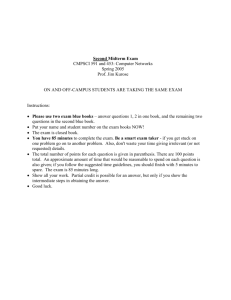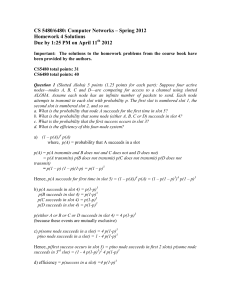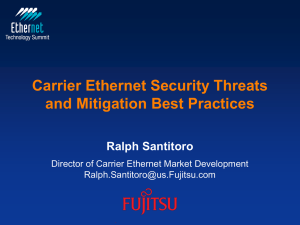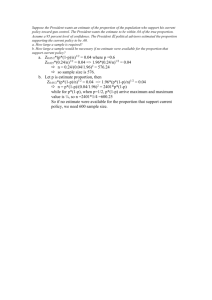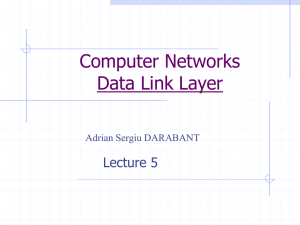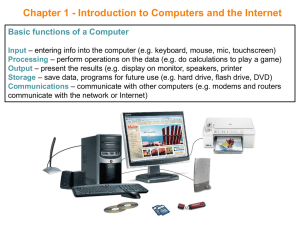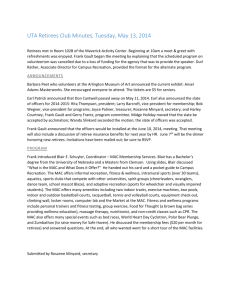Problem 3
advertisement
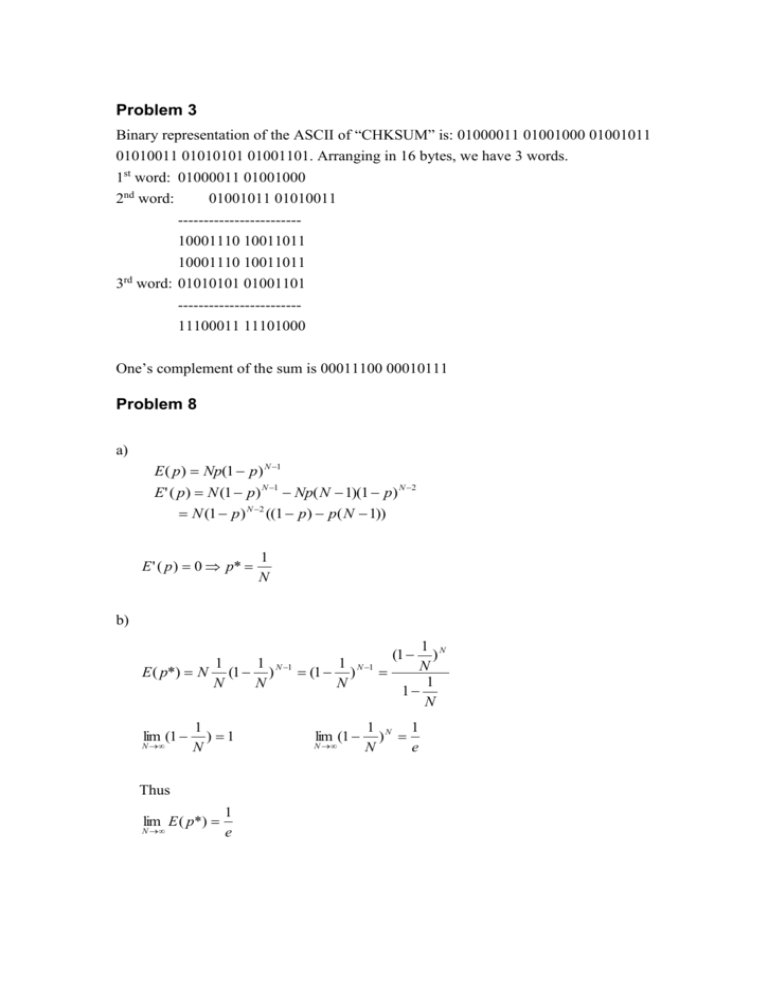
Problem 3 Binary representation of the ASCII of “CHKSUM” is: 01000011 01001000 01001011 01010011 01010101 01001101. Arranging in 16 bytes, we have 3 words. 1st word: 01000011 01001000 2nd word: 01001011 01010011 -----------------------10001110 10011011 10001110 10011011 rd 3 word: 01010101 01001101 -----------------------11100011 11101000 One’s complement of the sum is 00011100 00010111 Problem 8 a) E ( p) Np(1 p) N 1 E ' ( p) N (1 p) N 1 Np( N 1)(1 p) N 2 N (1 p) N 2 ((1 p) p( N 1)) E ' ( p ) 0 p* 1 N b) E ( p*) N lim (1 N 1 1 1 (1 ) N 1 (1 ) N 1 N N N 1 ) 1 N Thus lim E ( p*) N 1 e lim (1 N 1 N ) N 1 1 N (1 1 N 1 ) N e Problem 11 a) (1 – p(A))4 p(A) where, p(A) = probability that A succeeds in a slot p(A) = p(A transmits and B does not and C does not and D does not) = p(A transmits) p(B does not transmit) p(C does not transmit) p(D does not transmit) = p(1 – p) (1 – p)(1-p) = p(1 – p)3 Hence, p(A succeeds for first time in slot 5) = (1 – p(A))4 p(A) = (1 – p(1 – p)3)4 p(1 – p)3 b) p(A succeeds in slot 4) = p(1-p)3 p(B succeeds in slot 4) = p(1-p)3 p(C succeeds in slot 4) = p(1-p)3 p(D succeeds in slot 4) = p(1-p)3 p(either A or B or C or D succeeds in slot 4) = 4 p(1-p)3 (because these events are mutually exclusive) c) p(some node succeeds in a slot) = 4 p(1-p)3 p(no node succeeds in a slot) = 1 - 4 p(1-p)3 Hence, p(first success occurs in slot 3) = p(no node succeeds in first 2 slots) p(some node succeeds in 3rd slot) = (1 - 4 p(1-p)3)2 4 p(1-p)3 d) efficiency = p(success in a slot) =4 p(1-p)3 Problem 15 a) No. E can check the subnet prefix of Host F’s IP address, and then learn that F is on the same LAN. Thus, E will not send the packet to the default router R1. Ethernet frame from E to F: Source IP = E’s IP address Destination IP = F’s IP address Source MAC = E’s MAC address Destination MAC = F’s MAC address b) No, because they are not on the same LAN. E can find this out by checking B’s IP address. Ethernet frame from E to R1: Source IP = E’s IP address Destination IP = B’s IP address Source MAC = E’s MAC address Destination MAC = The MAC address of R1’s interface connecting to Subnet 3. c) Switch S1 will broadcast the Ethernet frame via both its interfaces as the received ARP frame’s destination address is a broadcast address. And it learns that A resides on Subnet 1 which is connected to S1 at the interface connecting to Subnet 1. And, S1 will update its forwarding table to include an entry for Host A. Yes, router R1 also receives this ARP request message, but R1 won’t forward the message to Subnet 3. B won’t send ARP query message asking for A’s MAC address, as this address can be obtained from A’s query message. Once switch S1 receives B’s response message, it will add an entry for host B in its forwarding table, and then drop the received frame as destination host A is on the same interface as host B (i.e., A and B are on the same LAN segment). Problem 17 Wait for 536 x 115 = 61640 bit times. For 10 Mbps, this wait is 61.64 103 bits 6.164 msec 10 106 bps For 100 Mbps, the wait is 616.4 sec. Problem 26 Action B sends frame to E Switch Table State Link(s) packet is Explanation forwarded to a Switch learns interface A, C, D, E, and F corresponding to MAC address of B Since switch table is empty, so switch does not know the interface corresponding to MAC address of E E replies with Switch learns interface B a frame to B corresponding to MAC address of E Since switch already knows interface corresponding to MAC address of B A sends frame to B Since switch already knows the interface corresponding to a Switch learns the B interface corresponding to MAC address of A MAC address of B B replies with Switch table state A a frame to A remains the same as before Since switch already knows the interface corresponding to MAC address of A Problem 31 (The following description is short, but contains all major key steps and key protocols involved.) Your computer first uses DHCP to obtain an IP address. You computer first creates a special IP datagram destined to 255.255.255.255 in the DHCP server discovery step, and puts it in a Ethernet frame and broadcast it in the Ethernet. Then following the steps in the DHCP protocol, you computer is able to get an IP address with a given lease time. A DHCP server on the Ethernet also gives your computer a list of IP addresses of firsthop routers, the subnet mask of the subnet where your computer resides, and the addresses of local DNS servers (if they exist). Since your computer’s ARP cache is initially empty, your computer will use ARP protocol to get the MAC addresses of the first-hop router and the local DNS server. Your computer first will get the IP address of the Web page you would like to download. If the local DNS server does not have the IP address, then your computer will use DNS protocol to find the IP address of the Web page. Once your computer has the IP address of the Web page, then it will send out the HTTP request via the first-hop router if the Web page does not reside in a local Web server. The HTTP request message will be segmented and encapsulated into TCP packets, and then further encapsulated into IP packets, and finally encapsulated into Ethernet frames. Your computer sends the Ethernet frames destined to the first-hop router. Once the router receives the frames, it passes them up into IP layer, checks its routing table, and then sends the packets to the right interface out of all of its interfaces. Then your IP packets will be routed through the Internet until they reach the Web server. The server hosting the Web page will send back the Web page to your computer via HTTP response messages. Those messages will be encapsulated into TCP packets and then further into IP packets. Those IP packets follow IP routes and finally reach your first-hop router, and then the router will forward those IP packets to your computer by encapsulating them into Ethernet frames. Problem 32 a) Each flow evenly shares a link’s capacity with other flows traversing that link, then the 80 flows crossing the B to access-router 10 Gbps links (as well as the access router to border router links) will each only receive 10 Gbps / 80 = 125 Mbps b) In Topology of Figure 5.31, there are four distinct paths between the first and third tier-2 switches, together providing 40 Gbps for the traffic from racks 1-4 to racks 9-12. Similarly, there are four links between second and fourth tier-2 switches, together providing 40 Gbps for the traffic from racks 5-8 to 13-16. Thus the total aggregate bandwidth is 80 Gbps, and the value per flow rate is 1 Gbps. c) Now 20 flows will need to share each 1 Gbps bandwidth between pairs of TOR switches. So the host-to-host bit rate will be 0.5 Gbps.
